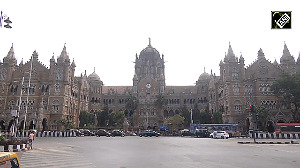World-class infrastructure has emerged as one of the most important necessities for unleashing high and sustained growth and alleviation of poverty in any economy.
And with poor infrastructure to support other growth initiatives, the Indian economy continues to be a laggard when compared to its developing peers. From a policy perspective, there has been a growing consensus that a private-public partnership is required to remove difficulties concerning the development of infrastructure in the country.
In this article, we take a look, through the eyes of the economic survey of 2004-05, on the kind of progress we have made on the infrastructure front in the past year.
Power The economic survey has indicated that while the capacity addition plan for FY05 is in line with what was projected earlier, effective enforcement of the Electricity Act of 2003 is necessary for solving the problems facing the power sector, in the areas of generation, transmission and distribution.
The economic survey has indicated that while the capacity addition plan for FY05 is in line with what was projected earlier, effective enforcement of the Electricity Act of 2003 is necessary for solving the problems facing the power sector, in the areas of generation, transmission and distribution.
As a matter of fact, out of the 5,245 MW of addition projected for the country's generation capacity in FY05, only 3,100 (59%) has been commissioned during the period between April and November.
This is slow considering that we have set for ourselves a target of adding 100,000 MW during the tenth and eleventh five-year plans. Also, considering that China has added around 30,000 MW in 2004 alone (even when it has around 3 times Indian's generation capacity), we have only ourselves to blame for the slow progress made on this front. The survey has also indicated that during the period 1992-2004, power generation capacity in the country has grown at a CAGR of 4.2% while the GDP growth has been 6.4%.
We believe that this has been the major reason why the demand-supply mismatch has deepened over the years. This is because of the fact that the growth rate of demand for power in developing countries is generally higher that of the GDP. In India, the elasticity ratio is around 1.5, which means that if the economy is to grow at a CAGR of 7%, the rate of growth of power supply needs to be over 10% annually.
The economic survey has indicated that India has an estimated unutilized hydro power potential of more than 150,000 MW (over the current capacity of 32,000 MW). In order to tap this potential, the government has identified 162 projects spread across 16 states, with an aggregate capacity of 50,000 MW.
What is enthusing is that the plant load factor (PLF), which is an important measure of the operational efficiency of thermal power plants, has increased from 64.6% in 1998-99 to around 72.9% in the nine-month period ending December 2004.
One of the concerns on this front has been the low PLFs of the state electricity board in comparison to the private players. Also, the PLF of eastern states are particularly low, with the lowest being 3.2% (!) for Bihar SEB. If the PLF of eastern region is brought at par with the rest of the country, it would induce additional generation of 47 bn Kwh per year.
Other key points
Gross subsidy on account of sale of electricity to agriculture is likely to increase from Rs 233 bn in 2003-04 to Rs 238 bn in 2004-05 and 254 bn in 2005-6.
Earlier a village was defined as being electrifies is at least one connection existed. In 2003-04, this definition was revised to require linking at least 10% of the households. Using this definition, around 19% of India's villages still remain unelectrified.
As per the survey, a considerable progress has been made on the settlement of dues payable by the SEBs to the central power sector undertakings. Also, with a view to give a boost to state governments, SEBs and utilities have taken adequate steps towards reduction of transmission, distribution and commercial losses.
The government is implementing the APRDP, through which it has allocated Rs 35 bn in 2004-05. The recently announced National Electricity Policy as envisaged in the Electricity Act of 2003, aims to provide electricity to all households in five years and to fully meet power demand by 2012.
Telecom
Few areas of the Indian economy have enjoyed as sharp a pace of structural change as the telecom sector. This rapid pace has been the outcome of increasing competition among service providers and rapid technology advancements. The survey has indicated that the subscriber base has continued to grow at a rapid pace.
Total number of telephones has risen from 22.8 m in 1999 to 88.6 m at the end of October 2004. During the first seven months of 2004-05, 12 m phones were added, mainly in the mobile segment. Overall, the tele-density has risen from just 2.3 in 1999 to over 8.2 in October 2004.
However, we continue to lag behind other emerging nations like Brazil and China (see chart below). In order to close the gap, there is a need to maintain the current pace of reforms in the sector, like encouraging entry of new players and driving prices down through competition.
 |
 |
The survey states that the telecom sector has seen structural changes in ways that the mobile subscriber base has crossed the fixed line base and private sector players have been growing much faster than their public sector peers.
The increasing penetration of mobile phones has been brought about by rising income levels, increasing need to be 'on the move', and of course, from the service providers' side, the lowering capital costs of establishing a mobile telephony network. The economy survey indicates that by the end of 2007, Indian's telecom base has the potential to cross 250 m.
However to reach this target, we believe that a large amount of investment is required. In the past, the economic survey states that one important source of funding has been the FDI route. As a matter of fact, the actual FDI flow in the sector during the period January 2001and August 2004 has been Rs 57.6 bn, around 56% of what came in during August 1991 and August 2004. And the recent policy decision of the government to hike these the FDI levels to 74% from the earlier 49% is a step in the right direction.
Infrastructure: Other important aspects
At the end of September 2004, there were 617 projects with and estimated cost of Rs 2,671 bn. Out of these, around 149 projects faced cost overruns of 22.2%. Then there are 237 projects, which have a time overrun ranging from 2 months to 13 years.
The survey states that since infrastructure projects have long gestation periods and are not financially viable on their own, the government is promoting public-private partnerships through a special facility called the 'viability gap funding.' This facility is meant to reduce capital cost of projects and to make them viable and attractive for private sector investments.
Efforts to restructure and modernise the Mumbai and Delhi airports through the JV route are underway. Two new greenfield airports with private sector participation are proposed at Hyderabad and Bangalore. Approximate cost is around Rs 13 bn per airport.
As of January 31 2005, 5,418 kms of the national highway development project (out of a total of 14,279 kms) has been completed. The Golden Quadrilateral project is likely to be completed by December 2005. The North-South and the East-West corridors are likely to be completed by December 2007.
Outlook
There is no gainsaying the fact that a developing country like India needs a strong infrastructure support if it were to grow strongly in the future. The improvement in infrastructure will definitely have an impact on the GDP growth of the country and the overall development of its citizens.
However, the Indian governments of the past have found it intricate to frame an appropriate policy for the improvement of the infrastructure sector in the past. And this has cost us heavily in terms of both time and cost overruns of infrastructure projects.
 |
 |
So, what is required now, as mentioned above is, a framework that promoted public-private partnerships in infrastructure development across the country. The economic survey states that the telecom sector can very well serve as a role model where competition has delivered immense benefits.
In all areas of infrastructure, namely roads, power, ports, aviation and urban infrastructure, the private sector has to be provided the necessary support by the government on carry on the development process. Not only will this aid the sustenance of rapid growth in GDP as seen in the past two years, it will also be a source of employment to millions of Indians.
This is part of Equitymaster's Budget 2005-06 series. Equitymaster.com is one of India's premier finance portals. The Web site offers a user-friendly portfolio tracker, a weekly buy/sell recommendation service and research reports on India's top companies.








 © 2025
© 2025